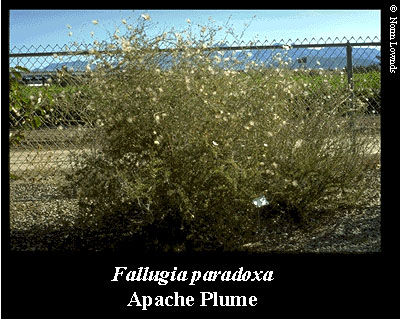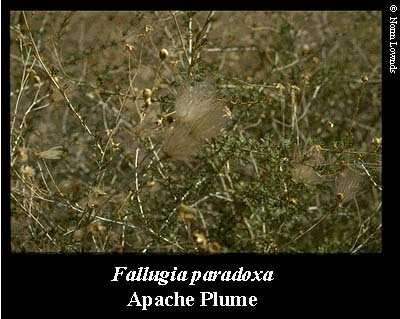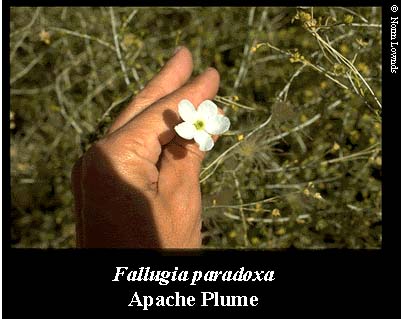Apache Plume
Fallugia Paradoxa



Apache Plume is found in southeastern California and southern Nevada, to southern Colorado, west Texas, New Mexico and Arizona, to northern Mexico. Apache Plume usually grows on gravelly and rocky slopes, roadsides, dry washes and hillsides between 4,000 and 8,000 feet. The blooms are round, white flowers, with yellow centers, 1 to 2 inches wide, and develop April through June. They have 5 petals, many stamens and grow from the rim of small cups. This evergreen shrub, a member of the Rose Family (Rosaceae), grows up to 8 feet high. Apache Plume has a shrub-like appearance, having numerous branches at the base. Its small grayish, downy leaves are pinnately divided into linear divisions, attached alternately on slender stems. They are about 3 / 4 inches long and curved slightly downward. The silvery puffs of fruit heads have many styles emanating from a feathery plume up to 2 inches long. These white-to-pink plumes grow from a seed-like base at the tips of tangled, slender branches. This evergreen shrub will grow well in Las Cruces and surrounding areas because of the plants low consumption of water and because of the soil conditions and weather.
- Terri Robinson Agro / Hort 100, Spring 2000
Apache Plume is an evergreen shrub that has the ability to grow throughout the driest areas of the southwest. It can be found growing in the four deserts of the United States. Its eye-catching beauty makes it a plant that would be very desirable for anyone looking for the look of the southwest in their landscaping. This plant can grow in rocky sloping soil, along roadsides, or in dry washouts between 4,000 and 8,000 feet above sea level, making it very low maintenance. Flowering occurs between May and June, bringing little white flowers with yellow centers. Small gray leaves, about 3 / 4" long cover the plant and its fruit can be a white or pink plume growing up to 2" long. It can grow up to 6 feet tall and usually requires no special caring other than being watered occasionally. The name Apache Plume came about because it looks very similar to an Apache war bonnet.
- Andrew Jeffers Agro / Hort 100, Spring 2000